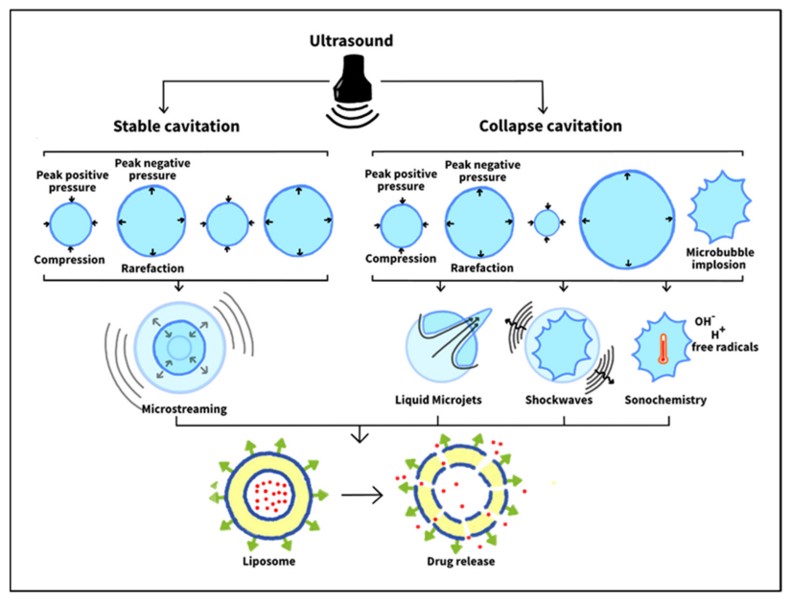At the vanguard of pharmaceutical innovation, Creative Biolabs has developed a comprehensive suite of stimuli-responsive liposomal solutions, including ultrasound-responsive liposome, designed to address the diverse and sophisticated needs of smart drug delivery. These advanced systems are engineered to harness the precision of ultrasound to trigger the release of encapsulated drugs, offering a new dimension in targeted drug administration.
Ultrasound (US), a high-frequency mechanical wave with frequencies exceeding 20 kHz, is characterized by its non-invasiveness, spatial accuracy, and the ability to be used repeatedly without leaving any radiation residue. Compared to light and other stimulus-responsive techniques, ultrasound demonstrates enhanced controllability, superior tissue penetration, minimal harm to surrounding healthy tissues, and the unique ability to combine diagnostic and therapeutic procedures.
Ultrasound-sensitive liposome, also known as ultrasound-triggered liposome, penetrate tissues under varying intensities of applied ultrasound and undergo processes of contraction, oscillation, expansion, and disruption, leading to responsive drug release at the target site. This mechanism minimizes adverse systemic side effects on healthy tissues, aiding in the achievement of therapeutic goals. By modulating ultrasound parameters such as frequency and intensity, targeted and quantified drug release in the area of interest can be achieved. High-Intensity focused ultrasound is frequently used as an external stimulus for ultrasound-responsive liposome to trigger drug release.
For an ideal ultrasound-responsive liposome, two critical conditions must be met:
Ultrasound-responsive liposome harness thermal and mechanical effects to rupture liposome, release drugs, and inflict mechanical damage or increase temperature in target tissues or cells. Ultrasound can also elevate intracellular reactive oxygen species (ROS), enhancing the fluidity of phospholipids and thereby promoting drug uptake.
Based on these mechanisms, ultrasound can achieve efficient controlled drug release, enhance the permeability of diseased tissues and cell membranes, and promote cellular uptake of drugs.
 Fig.1 Ultrasound-induced mechanical effects.1
Fig.1 Ultrasound-induced mechanical effects.1
Ultrasound Frequency: The attenuation and absorption of ultrasound waves in a medium are closely related to frequency. At higher frequencies, ultrasound energy is more readily attenuated and absorbed, reducing penetration into deeper tissues. Therefore, at high frequencies, thermal effects play a predominant role in energy transfer. In contrast, cavitation is more significant at lower frequencies. Lowering the ultrasound frequency enhances penetration depth, cavitation likelihood, and heating.
Ultrasound Intensity: Ultrasound intensity is defined as the power of the ultrasound beam divided by the surface area over which it propagates, and it is directly related to medium density, acoustic pressure, and the speed of ultrasound propagation in the medium. Increasing the intensity of the ultrasound allows for the control of energy delivery to the target site.
Creative Biolabs' ultrasound-responsive liposome exemplifies our commitment to leading-edge technology in drug delivery. To delve into the potential of our advanced solutions and integrate them into your treatment protocols, we invite you to contact us.
References
 For Research Use Only. Not For Clinical Use
For Research Use Only. Not For Clinical UseServices
Online Inquiry

